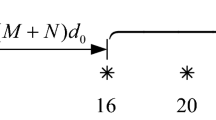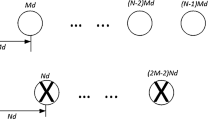Abstract
In this work, we attempt to solve the problem of achieving more consecutive degrees of freedom (DOF) in a coprime array for direction-of-arrival (DOA) estimation. Specifically, we propose a novel coprime array, which we term as optimal coprime array (OCA). OCA has attractive features in terms of achieving a large number of uniform DOF. Also, closed-form expression of the maximum uniform DOF for a specific number of sensors is available for the OCA, which is generally not found in the coprime arrays. Another advantage of the OCA is that it has less mutual coupling as a subarray of the OCA is translated. The properties of the OCA are analyzed considering two different situations. To increase the number of uniform DOF further, we extend it up to \({\varvec{k}}\)-times and prove that the proposed \({\varvec{k}}\)-times extended OCA (\({\varvec{k}}\)-OCA) works better than the existing \({\varvec{k}}\)-times extended coprime array in both attaining more consecutive DOF and reducing the mutual coupling effect. The \({\varvec{k}}\)-OCA achieves the maximum number of uniform DOF for a specified number of elements among all the existing coprime arrays. The simulation results show the effectiveness of the proposed OCA and the \({\varvec{k}}\)-OCA.





Similar content being viewed by others
Data Availability
Data sharing not applicable to this article as no datasets were generated or analyzed during the current study.
References
S.A. Alawsh, A.H. Muqaibel, Multi-level prime array for sparse sampling. IET Signal Proc. 12(6), 688–699 (2018)
D. Bush, N. Xiang, n-tuple coprime sensor arrays. J. Acoust. Soc. Am. 142(6), EL567–EL572 (2017)
S. Chandran, Advances in Direction-of-Arrival Estimation (Artech House, 2006)
Z. Chen, G. Gokeda, Y. Yu, Introduction to Direction-of-Arrival Estimation (Artech House, 2010)
B. Friedlander, A.J. Weiss, Direction finding in the presence of mutual coupling. IEEE Trans. Antennas Propag. 39(3), 273–284 (1991)
L.C. Godara, Application of antenna arrays to mobile communications, part II: beam-forming and direction-of-arrival considerations. Proc. IEEE 85(8), 1195–1245 (1997)
I. Gupta, A. Ksienski, Effect of mutual coupling on the performance of adaptive arrays. IEEE Trans. Antennas Propag. 31(5), 785–791 (1983)
S. Haykin, J. Reilly, V. Kezys, E. Vertatschitsch, Some aspects of array signal processing. IEE Proc. F-Radar Signal Process. 139(1), 1–26 (1992)
E. Holzman, Introduction to direction-of-arrival estimation (Chen, Z.; 2010) [reviews and abstracts]. IEEE Antennas Propag. Mag. 53(1), 110–111 (2011)
M. Ishiguro, Minimum redundancy linear arrays for a large number of antennas. Radio Sci. 15(6), 1163–1170 (1980)
H. Krim, M. Viberg, Two decades of array signal processing research: the parametric approach. IEEE Signal Process. Mag. 13(4), 67–94 (1996)
C.L. Liu, P.P. Vaidyanathan, Remarks on the spatial smoothing step in coarray MUSIC. IEEE Signal Process. Lett. 22(9), 1438–1442 (2015)
C.L. Liu, P. Vaidyanathan, Super nested arrays: sparse arrays with less mutual coupling than nested arrays, in Proc. IEEE Int. Conf. Acoust. Speech Signal Process. (ICASSP, 2016), pp. 2976–2980
C.L. Liu, P.P. Vaidyanathan, Super nested arrays: linear sparse arrays with reduced mutual coupling—part I: fundamentals. IEEE Trans. Signal Process. 64(15), 3997–4012 (2016)
C.L. Liu, P.P. Vaidyanathan, Super nested arrays: linear sparse arrays with reduced mutual coupling—part II: high-order extensions. IEEE Trans. Signal Process. 64(16), 4203–4217 (2016)
C.L. Liu, P.P. Vaidyanathan, Hourglass arrays and other novel 2-d sparse arrays with reduced mutual coupling. IEEE Trans. Signal Process. 65(13), 3369–3383 (2017)
J. Liu, Y. Zhang, Y. Lu, S. Ren, S. Cao, Augmented nested arrays with enhanced DOF and reduced mutual coupling. IEEE Trans. Signal Process. 65(21), 5549–5563 (2017)
D. Malioutov, M. Cetin, A.S. Willsky, A sparse signal reconstruction perspective for source localization with sensor arrays. IEEE Trans. Signal Process. 53(8), 3010–3022 (2005)
A.T. Moffet, Minimum-redundancy linear arrays. IEEE Trans. Antennas Propag. 16(2), 172–175 (1968)
P. Pal, P.P. Vaidyanathan, Nested arrays: a novel approach to array processing with enhanced degrees of freedom. IEEE Trans. Signal Process. 58(8), 4167–4181 (2010)
P. Pal, P.P. Vaidyanathan, Coprime sampling and the MUSIC algorithm, in 2011 Digital Signal Processing and Signal Processing Education Meeting (DSP/SPE) (IEEE, 2011), pp. 289–294
S.U. Pillai, Array Signal Processing (Springer, 2012)
S. Qin, Y.D. Zhang, M.G. Amin, Generalized coprime array configurations for direction-of-arrival estimation. IEEE Trans. Signal Process. 63(6), 1377–1390 (2015)
A. Raza, W. Liu, Q. Shen, Thinned coprime array for second-order difference co-array generation with reduced mutual coupling. IEEE Trans. Signal Process. 67(8), 2052–2065 (2019)
R. Roy, T. Kailath, ESPRIT-estimation of signal parameters via rotational invariance techniques. IEEE Trans. Acoust. Speech Signal Process. 37(7), 984–995 (1989)
R. Schmidt, Multiple emitter location and signal parameter estimation. IEEE Trans. Antennas Propag. 34(3), 276–280 (1986)
T.J. Shan, M. Wax, T. Kailath, On spatial smoothing for direction-of-arrival estimation of coherent signals. IEEE Trans. Acoust. Speech Signal Process. 33(4), 806–811 (1985)
J. Shi, G. Hu, X. Zhang, H. Zhou, Generalized nested array: optimization for degrees of freedom and mutual coupling. IEEE Commun. Lett. 22(6), 1208–1211 (2018)
P.P. Vaidyanathan, P. Pal, Sparse sensing with co-prime samplers and arrays. IEEE Trans. Signal Process. 59(2), 573–586 (2010)
H.L. Van Trees, Detection, Estimation, and Modulation Theory, Optimum Array Processing, Part IV (Wiley, 2002)
W. Wang, S. Ren, Z. Chen, Unified coprime array with multi-period subarrays for direction-of-arrival estimation. Digit. Signal Process. 74, 30–42 (2018)
X. Wang, X. Wang, Hole identification and filling in k-times extended co-prime arrays for highly-efficient DOA estimation. IEEE Trans. Signal Process. 67(10), 2693–2706 (2019)
X. Wang, Z. Chen, S. Ren, S. Cao, DOA estimation based on the difference and sum coarray for coprime arrays. Digit. Signal Process. 69, 22–31 (2017)
M. Yang, L. Sun, X. Yuan, B. Chen, Improved nested array with hole-free DCA and more degrees of freedom. Electron. Lett. 52(25), 2068–2070 (2016)
Z. Yang, L. Xie, C. Zhang, Off-grid direction of arrival estimation using sparse Bayesian inference. IEEE Trans. Signal Process. 61(1), 38–43 (2013)
M. Yangg, A.M. Haimovich, B. Chen, X. Yuan, A new array geometry for DOA estimation with enhanced degrees of freedom, in Proc. IEEE Int. Conf. Acoust. Speech Signal Process. (ICASSP, 2016), pp. 3041–3045
H. Zamani, H. Zayyani, F. Marvasti, An iterative dictionary learning-based algorithm for DOA estimation. IEEE Commun. Lett. 20(9), 1784–1787 (2016)
P. Zhao, G. Hu, Z. Qu et al., Enhanced nested array configuration with hole-free co-array and increasing degrees of freedom for DOA estimation. IEEE Commun. Lett. 23(12), 2224–2228 (2019)
W. Zheng, X. Zhang, Y. Wang, J. Shen, B. Champagne, Padded coprime arrays for improved DOA estimation: exploiting hole representation and filling strategies. IEEE Trans. Signal Process. 68, 4597–4611 (2020)
W. Zheng, X. Zhang, Y. Wang, M. Zhou, Q. Wu, Extended coprime array configuration generating large-scale antenna co-array in massive MIMO system. IEEE Trans. Veh. Technol. 68(8), 7841–7853 (2019)
Acknowledgements
Rajen Kumar Patra conveys deepest gratitude to Director, ITR, DRDO, for his support.
Author information
Authors and Affiliations
Corresponding author
Ethics declarations
Conflict of interest
The authors have no conflict of interest to declare.
Additional information
Publisher's Note
Springer Nature remains neutral with regard to jurisdictional claims in published maps and institutional affiliations.
Rights and permissions
Springer Nature or its licensor (e.g. a society or other partner) holds exclusive rights to this article under a publishing agreement with the author(s) or other rightsholder(s); author self-archiving of the accepted manuscript version of this article is solely governed by the terms of such publishing agreement and applicable law.
About this article
Cite this article
Patra, R.K., Dhar, A.S. Optimal Coprime Array: Properties, Optimization, and k-times extension. Circuits Syst Signal Process 42, 3770–3794 (2023). https://doi.org/10.1007/s00034-023-02292-8
Received:
Revised:
Accepted:
Published:
Issue Date:
DOI: https://doi.org/10.1007/s00034-023-02292-8




